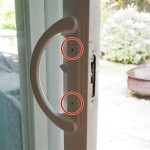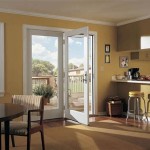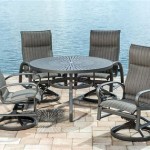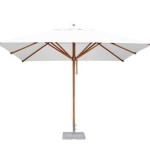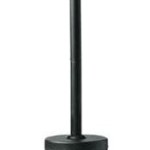```html
How to Stop a Patio Umbrella From Spinning
Patio umbrellas offer shade and comfort, enhancing outdoor living spaces. However, a common annoyance is the tendency for these umbrellas to spin uncontrollably, especially on windy days. This spinning can be distracting, disorienting, and potentially damaging to the umbrella itself or surrounding objects. Understanding the reasons why patio umbrellas spin and implementing effective solutions can significantly improve the outdoor experience.
The primary reason a patio umbrella spins is due to wind force acting unevenly upon its canopy. The umbrella's design creates an aerodynamic profile. Wind pushing on one side with greater intensity than the other causes the umbrella to rotate around its pole. This asymmetrical force is exacerbated by even slight imperfections in the canopy's design or damage accumulated over time. Furthermore, many umbrella bases, particularly those designed for portability, do not provide sufficient weight or stability to counteract the wind's rotational force.
The location of the umbrella also contributes to the spinning problem. An umbrella positioned in an exposed area is more susceptible to strong and gusty winds. Umbrellas placed near buildings or other structures can experience unpredictable wind patterns, leading to increased spinning. The shape and design of the surrounding landscape can also influence wind direction and intensity, further contributing to the issue.
Proper Weighting and Securing the Base
One of the most crucial steps in preventing umbrella spinning is ensuring the base is adequately weighted. Most standard umbrella bases are insufficient, especially during moderate to high winds. The manufacturer's recommended base weight is often an underestimate, particularly for larger umbrellas or those used in wind-prone areas. Increasing the base weight significantly improves stability and reduces the likelihood of spinning.
There are several ways to increase the base weight. One option is to replace the existing base with a heavier model designed for larger umbrellas or high-wind conditions. These bases are typically constructed from concrete, cast iron, or steel and can weigh considerably more than standard plastic or resin bases. Another option is to add weight to the existing base. This can be achieved by filling the base with sand, water, or concrete. Some bases are specifically designed with fill ports for this purpose.
Sand provides a decent amount of additional weight and is relatively inexpensive and readily available. However, it can become messy if the base leaks or is damaged. Water is another option, but it is less dense than sand or concrete and may not provide sufficient weight in very windy conditions. Additionally, water can freeze in cold climates, potentially cracking the base. Concrete offers the most significant increase in weight and provides excellent stability. However, it is a permanent solution and makes the base much more difficult to move.
In addition to weighting the base, securing it to the ground further enhances stability. This is particularly useful for umbrellas placed on decks or patios where anchoring is possible. There are several methods for securing the base, including using bolts or screws to attach it to the deck or patio surface. Specialized umbrella base anchors are also available, which are designed to be driven into the ground and then attached to the base. Always consider the material of the deck or patio surface when choosing an anchoring method to avoid damage.
For free-standing umbrellas, consider using ground anchors directly attached to the umbrella pole itself. These are driven deep into the ground and connected to the pole with straps or cables, providing additional resistance against spinning and tipping. This method is especially effective for umbrellas used on lawns or other soft surfaces.
Using Wind Vents and Tie-Downs
The design of the umbrella canopy plays a significant role in its susceptibility to spinning. Umbrellas with wind vents are designed to allow air to flow through the canopy, reducing the pressure differential between the top and bottom surfaces. This reduces the lifting force of the wind and minimizes the tendency to spin.
Wind vents are typically located at the top of the canopy and consist of a small opening or series of openings. The size and number of vents vary depending on the umbrella's size and design. While wind vents cannot completely eliminate spinning, they can significantly reduce its severity, especially in moderate winds. When purchasing a patio umbrella, selecting a model with adequate wind vents is advisable, particularly for areas prone to windy conditions.
Tie-downs provide another effective method for preventing umbrella spinning. These consist of ropes or straps that are attached to the umbrella canopy and then secured to the ground or surrounding structures. Tie-downs distribute the wind force more evenly across the canopy, reducing the rotational force and improving stability.
There are several ways to implement tie-downs. One option is to use durable rope or bungee cords to attach the canopy edges to stakes driven into the ground. Ensure the ropes are taut but not overly tight, as this can strain the canopy fabric. Another option is to attach the canopy to nearby furniture or railings using clips or straps. This is particularly useful for umbrellas placed on decks or patios. Choose tie-down materials that are weather-resistant and UV-resistant to prevent degradation over time.
For cantilever umbrellas, which extend out from a side-mounted pole, tie-downs are particularly important due to their greater leverage against the base. In these situations, secure the canopy to multiple points around the perimeter to maximize stability and prevent excessive movement.
Maintenance and Strategic Placement
Regular maintenance and strategic placement are often overlooked but are crucial for preventing umbrella spinning. Over time, the canopy fabric can become stretched, torn, or damaged, leading to uneven wind resistance and increased spinning. Regular inspection of the canopy is essential. Repairing any tears or holes promptly prevents further damage and maintains the canopy's aerodynamic integrity.
Cleaning the canopy regularly removes dirt, debris, and mildew, which can add weight and affect the canopy's performance. Use a mild soap and water solution to clean the fabric, and ensure it is completely dry before storing the umbrella. Applying a UV protectant spray can also help to prevent fading and deterioration of the canopy material.
The location of the umbrella significantly impacts its susceptibility to spinning. Avoid placing the umbrella in exposed areas where it is directly subjected to strong winds. Positioning the umbrella near a building or other structure can provide some protection from the wind. However, it can also create unpredictable wind patterns, so careful consideration is necessary.
Consider the prevailing wind direction when placing the umbrella. Orienting the umbrella so that the wind flows more evenly across the canopy can reduce the tendency to spin. If possible, use landscaping features, such as trees or shrubs, to provide a natural windbreak. However, be mindful of potential damage from falling branches or debris.
When not in use, it is always best to close and secure the umbrella, especially during periods of strong winds or inclement weather. A closed umbrella presents a much smaller surface area to the wind, reducing the risk of damage or spinning. Use a protective cover to shield the umbrella from the elements and prevent fading or deterioration.
By implementing these strategies – proper weighting and securing the base, utilizing wind vents and tie-downs, and maintaining the umbrella while considering its strategic placement – one can significantly reduce the likelihood of a patio umbrella spinning and enjoy a more comfortable and relaxing outdoor experience.
```
9 Tips On How To Keep Your Patio Umbrella From Spinning

6 Tips For How To Keep Cantilever Umbrella From Spinning

Keep Patio Umbrella Steady Tips To Prevent Spinning In The Wind

How To Stabilize And Prevent Swaying Spinning Of A Cantilever Umbrella

How To Stop A Spinning Patio Umbrella Youtube

How To Stop Your Umbrella From Blowing Away An Engineers Guide Stay Cool

15 Clever Ways To Stop Your Parasol Spinning In The Wind

How To Stop A Spinning Patio Umbrella Youtube

15 Clever Ways To Stop Your Parasol Spinning In The Wind

Keep Patio Umbrella Steady Tips To Prevent Spinning In The Wind
See Also


